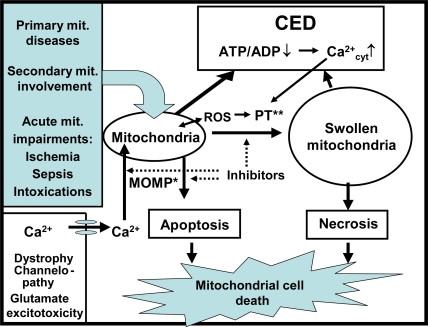Figure 2.
Mitochondrial cell death. Loss of mitochondrial capacity to synthesize ATP in the processes of OXPHOS leads to cellular energetic depression (CED) characterized by decreased cytosolic phosphorylation potential and increased cytosolic Ca2+ concentration (Ca2+cyt) that leads to reduced ability of cell to do work. The resulting ROS formation and Ca2+ overload further impair the structure and function of mitochondria. In mild stage of CED, when mitochondria can generate some amounts of ATP, mitochondria launch a program of apoptotic cell death by release of cytochrome c. At pronounced CED, when the cytoplasmic ATP levels fall below the levels required for processing the ATP-dependent apoptotic reactions, the cell dies from necrosis. Both, the apoptotic and necrotic death pathways that are mediated by mitochondrial impairments can be classified as of mitochondrial cell death (MCD). The molecular mechanism of mitochondrial outer membrane permeabilization (MOMP) and PT are potential targets for therapeutic interventions preventing mitochondrial cell death.

